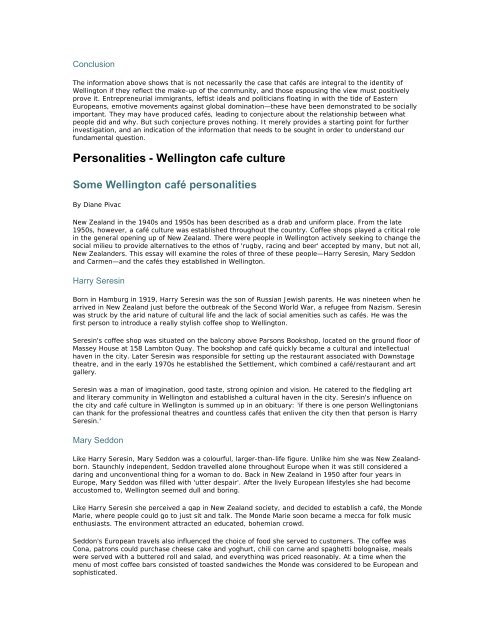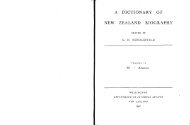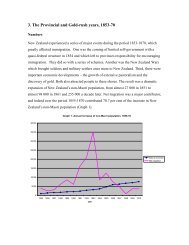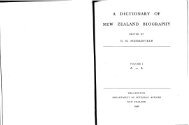Wellington cafe culture 1920-2000 - NZHistory.net.nz
Wellington cafe culture 1920-2000 - NZHistory.net.nz
Wellington cafe culture 1920-2000 - NZHistory.net.nz
You also want an ePaper? Increase the reach of your titles
YUMPU automatically turns print PDFs into web optimized ePapers that Google loves.
Conclusion<br />
The information above shows that is not necessarily the case that cafés are integral to the identity of<br />
<strong>Wellington</strong> if they reflect the make-up of the community, and those espousing the view must positively<br />
prove it. Entrepreneurial immigrants, leftist ideals and politicians floating in with the tide of Eastern<br />
Europeans, emotive movements against global domination—these have been demonstrated to be socially<br />
important. They may have produced cafés, leading to conjecture about the relationship between what<br />
people did and why. But such conjecture proves nothing. It merely provides a starting point for further<br />
investigation, and an indication of the information that needs to be sought in order to understand our<br />
fundamental question.<br />
Personalities - <strong>Wellington</strong> <strong>cafe</strong> <strong>culture</strong><br />
Some <strong>Wellington</strong> café personalities<br />
By Diane Pivac<br />
New Zealand in the 1940s and 1950s has been described as a drab and uniform place. From the late<br />
1950s, however, a café <strong>culture</strong> was established throughout the country. Coffee shops played a critical role<br />
in the general opening up of New Zealand. There were people in <strong>Wellington</strong> actively seeking to change the<br />
social milieu to provide alternatives to the ethos of 'rugby, racing and beer' accepted by many, but not all,<br />
New Zealanders. This essay will examine the roles of three of these people—Harry Seresin, Mary Seddon<br />
and Carmen—and the cafés they established in <strong>Wellington</strong>.<br />
Harry Seresin<br />
Born in Hamburg in 1919, Harry Seresin was the son of Russian Jewish parents. He was ni<strong>net</strong>een when he<br />
arrived in New Zealand just before the outbreak of the Second World War, a refugee from Nazism. Seresin<br />
was struck by the arid nature of cultural life and the lack of social amenities such as cafés. He was the<br />
first person to introduce a really stylish coffee shop to <strong>Wellington</strong>.<br />
Seresin's coffee shop was situated on the balcony above Parsons Bookshop, located on the ground floor of<br />
Massey House at 158 Lambton Quay. The bookshop and café quickly became a cultural and intellectual<br />
haven in the city. Later Seresin was responsible for setting up the restaurant associated with Downstage<br />
theatre, and in the early 1970s he established the Settlement, which combined a café/restaurant and art<br />
gallery.<br />
Seresin was a man of imagination, good taste, strong opinion and vision. He catered to the fledgling art<br />
and literary community in <strong>Wellington</strong> and established a cultural haven in the city. Seresin's influence on<br />
the city and café <strong>culture</strong> in <strong>Wellington</strong> is summed up in an obituary: 'if there is one person <strong>Wellington</strong>ians<br />
can thank for the professional theatres and countless cafés that enliven the city then that person is Harry<br />
Seresin.'<br />
Mary Seddon<br />
Like Harry Seresin, Mary Seddon was a colourful, larger-than-life figure. Unlike him she was New Zealandborn.<br />
Staunchly independent, Seddon travelled alone throughout Europe when it was still considered a<br />
daring and unconventional thing for a woman to do. Back in New Zealand in 1950 after four years in<br />
Europe, Mary Seddon was filled with 'utter despair'. After the lively European lifestyles she had become<br />
accustomed to, <strong>Wellington</strong> seemed dull and boring.<br />
Like Harry Seresin she perceived a gap in New Zealand society, and decided to establish a café, the Monde<br />
Marie, where people could go to just sit and talk. The Monde Marie soon became a mecca for folk music<br />
enthusiasts. The environment attracted an educated, bohemian crowd.<br />
Seddon's European travels also influenced the choice of food she served to customers. The coffee was<br />
Cona, patrons could purchase cheese cake and yoghurt, chili con carne and spaghetti bolognaise, meals<br />
were served with a buttered roll and salad, and everything was priced reasonably. At a time when the<br />
menu of most coffee bars consisted of toasted sandwiches the Monde was considered to be European and<br />
sophisticated.








